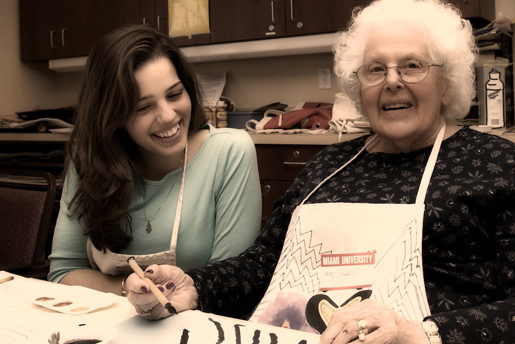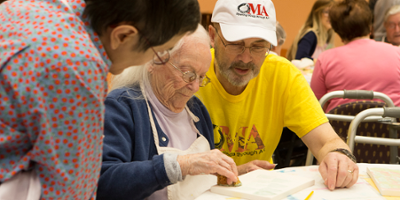OMA designated a Quality Improvement Project by Ohio Department of Aging

 Opening Minds through Art (OMA), an acclaimed program of the Scripps Gerontology Center at Miami University, has been designated as a Quality Improvement Project (QIP) by the Ohio Department of Aging (ODA).
Opening Minds through Art (OMA), an acclaimed program of the Scripps Gerontology Center at Miami University, has been designated as a Quality Improvement Project (QIP) by the Ohio Department of Aging (ODA).
Every Ohio nursing home must participate in at least one approved QIP every two years to qualify for licensing. OMA is one of eight approved programs to meet this requirement. "Ohio is committed to ensuring the highest quality of life and care for our neighbors who reside in the state's 967 nursing homes," said Bonnie K. Burman, director of the Ohio Department of Aging. "We proudly support programs, like OMA, that help build relationships and lead to the most responsive care and caring possible, thus not only improving our elders' well-being, but also enhancing the lives of those who care for them.”
OMA is an intergenerational art program for people with dementia developed in 2007 by Elizabeth Lokon, associate professor and senior research associate at Scripps. OMA trains nursing home staff to collaborate with high schools, colleges and other service organizations to provide a person-centered visual arts program that taps the elders’ creativity and imagination, rather than their memory. The one-on-one art-making sessions also provide volunteers, staff and family members with transformative learning experiences that address their fear of memory loss and getting older. Research shows that OMA is beneficial to those with dementia and contributes to a positive change in volunteers’ attitudes towards aging and dementia.
The one-on-one art-making sessions also provide volunteers, staff and family members with transformative learning experiences that address their fear of memory loss and getting older. Research shows that OMA is beneficial to those with dementia and contributes to a positive change in volunteers’ attitudes towards aging and dementia.OMA is now offered at 29 locations across the United States and Canada, pairing more than 400 volunteers with people with dementia annually. Together with Cedar Village Retirement Community, OMA received a Best Practice Award from LeadingAge Ohio in 2011. It was also featured as a model program in the Creative Caregiving Initiative by the National Center for Creative Aging (2015) and was recognized as a Program of Distinction by Generations United (2015).
OMA is now offered at 29 locations across the United States and Canada, pairing more than 400 volunteers with people with dementia annually. Together with Cedar Village Retirement Community, OMA received a Best Practice Award from LeadingAge Ohio in 2011. It was also featured as a model program in the Creative Caregiving Initiative by the National Center for Creative Aging (2015) and was recognized as a Program of Distinction by Generations United (2015).

